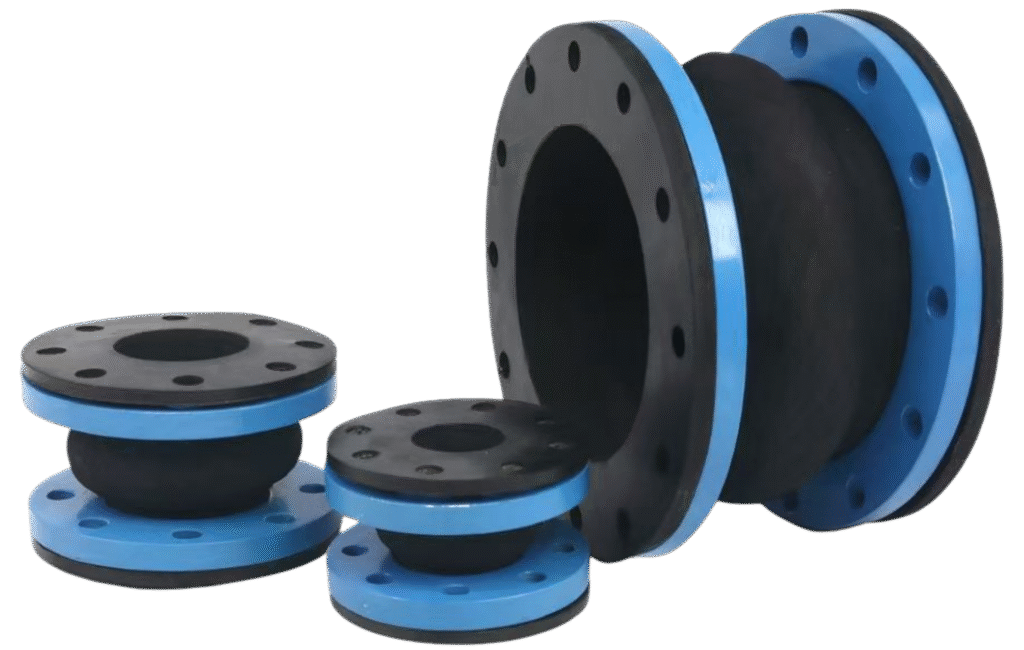Key Applications of Rubber Expansion Joints in Mining and Mineral Processing
Rubber expansion joints play a crucial role in the mining and mineral processing industries. These industries involve harsh environments, often characterized by vibration, temperature fluctuations, corrosive media, and wear. Rubber expansion joints are widely used in slurry pipelines, wastewater pipelines, oil and gas pipelines, and other systems that require flexible connections. Their main functions include absorbing displacements, damping vibrations, and preventing damage to pipelines due to thermal expansion or mechanical vibrations. They effectively withstand extreme environmental conditions such as high pressure, high temperature, and corrosion, while also providing the necessary flexibility to ensure the stability and safety of pipeline systems during long-term operation.
In mineral processing, especially when conveying slurries, oil, and water mixtures, rubber expansion joints play an important role. Their excellent resistance to corrosion, abrasion, and high temperatures makes them the ideal connection component for mineral processing systems. By selecting the appropriate materials (such as EPDM, NBR, etc.), rubber expansion joints can meet the transportation needs of different types of slurries and chemicals, preventing pipeline leaks and ensuring the normal operation of the system.



Introduction to Rubber Expansion Joints in Mining and Mineral Processing
In the mining and mineral processing industries, rubber expansion joints are vital components of pipeline systems, responsible for flexible connections and stress relief. Mining operations are subject to various harsh conditions such as extreme temperature variations, mechanical vibrations, and corrosive slurry or chemical media. Rubber expansion joints help mitigate the effects of these factors, alleviating displacement, pressure fluctuations, and vibrations to ensure the stability of pipelines and equipment.
Mining and mineral processing pipeline systems often face high wear and high corrosion challenges. For example, slurry pipeline systems transporting water and solid mixtures (such as ores) require materials with exceptional durability. Rubber expansion joints are often made from highly abrasion-resistant NBR or EPDM materials, ensuring their high efficiency and durability in such environments. By connecting industrial equipment such as pumps, crushers, and vibrating screens, rubber expansion joints provide necessary flexibility, reduce stress and vibration between equipment, and minimize wear, thereby extending the service life of equipment.
How do Rubber Expansion Joints help with Vibration Control?
During mineral processing, various machines like crushers, vibrating screens, and pumps generate vibrations that can affect the system’s stability. Rubber expansion joints, through their elasticity and flexibility, effectively absorb and dampen these vibrations, preventing them from transmitting through the pipelines and equipment. Without these vibration dampening joints, excessive vibrations could accelerate equipment wear and cause pipeline and connection component failure.
Can Rubber Expansion Joints Handle the High Wear of Mining Environments?
Mining environments often involve abrasive slurries, sands, and ores, putting high demands on materials used in rubber expansion joints. NBR (nitrile rubber) and EPDM (ethylene propylene diene monomer) are commonly chosen for their excellent abrasion resistance and chemical resistance. For extremely high wear environments, reinforced joints are selected, which are specifically designed to enhance wear resistance and prolong service life.
How Do Extreme Temperatures Affect Rubber Expansion Joints in Mining?
In mining, equipment frequently operates in high or low-temperature conditions. Temperature fluctuations can impact the performance of rubber expansion joints, causing aging, hardening, or cracking of the material. High temperatures can cause rubber to lose elasticity, reducing its vibration-damping capabilities, while low temperatures may make rubber brittle, increasing the risk of cracking. To address this challenge, materials like Viton or high-temperature-resistant EPDM are commonly used to ensure stable performance in extreme temperatures.
Can Rubber Expansion Joints Prevent Water Leaks in Mining Pipeline Systems?
In slurry pipeline systems, water or other chemical media leaks can pose significant safety risks and environmental hazards. Rubber expansion joints play a crucial role in maintaining a tight seal in pipelines when they undergo displacement due to thermal expansion, mechanical vibrations, or ground movement. They ensure that water or slurry leaks are effectively prevented, safeguarding the integrity and safety of the system.
Which Material is Best for Rubber Expansion Joints in Slurry Pipelines?
Slurry pipelines often transport corrosive and abrasive liquids and solids, requiring materials that can withstand these harsh conditions. NBR rubber is commonly chosen for its superior oil resistance and abrasion resistance, making it ideal for slurry pipelines. EPDM is also widely used in other pipeline systems in mineral processing due to its excellent acid and alkali resistance, high-temperature tolerance, and resistance to aging.
How Can Rubber Expansion Joints Solve Alignment Issues in Mining Systems?
In mining environments, pipelines can become misaligned due to equipment movement, ground shifts, or temperature variations. Rubber expansion joints provide flexible connections that allow for a certain degree of misalignment, thus reducing stress on the pipeline and equipment. This flexibility helps prevent pipeline fractures, joint failures, and ensures long-term stability of the system.


